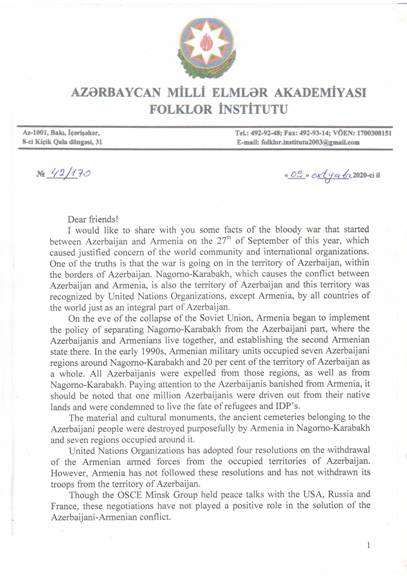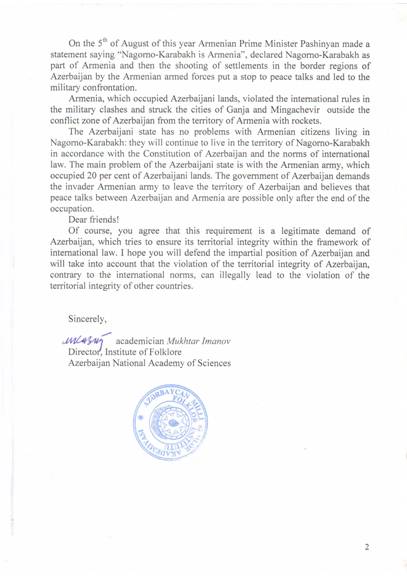Dear friends!

I would like to share with you some facts of the bloody war that started between Azerbaijan and Armenia on the 27th of September of this year, which caused justified concern of the world community and international organizations. One of the truths is that the war is going on in the territory of Azerbaijan, within the borders of Azerbaijan. Nagorno-Karabakh, which causes the conflict between Azerbaijan and Armenia, is also the territory of Azerbaijan and this territory was recognized by United Nations Organizations, except Armenia, by all countries of the world just as an integral part of Azerbaijan.
On the eve of the collapse of the Soviet Union, Armenia began to implement the policy of separating Nagorno-Karabakh from the Azerbaijani part, where the Azerbaijanis and Armenians live together, and establishing the second Armenian state there. In the early 1990s, Armenian military units occupied seven Azerbaijani regions around Nagorno-Karabakh and 20 per cent of the territory of Azerbaijan as a whole. All Azerbaijanis were expelled from those regions, as well as from Nagorno-Karabakh. Paying attention to the Azerbaijanis banished from Armenia, it should be noted that one million Azerbaijanis were driven out from their native lands and were condemned to live the fate of refugees and IDP’s.
The material and cultural monuments, the ancient cemeteries belonging to the Azerbaijani people were destroyed purposefully by Armenia in Nagorno-Karabakh and seven regions occupied around it.
United Nations Organizations has adopted four resolutions on the withdrawal of the Armenian armed forces from the occupied territories of Azerbaijan. However, Armenia has not followed these resolutions and has not withdrawn its troops from the territory of Azerbaijan.
Though the OSCE Minsk Group held peace talks with the USA, Russia and France, these negotiations have not played a positive role in the solution of the Azerbaijani-Armenian conflict.
On the 5th of August of this year Armenian Prime Minister Pashinyan made a statement saying “Nagorno-Karabakh is Armenia”, declared Nagorno-Karabakh as part of Armenia and then the shooting of settlements in the border regions of Azerbaijan by the Armenian armed forces put a stop to peace talks and led to the military confrontation.
Armenia, which occupied Azerbaijani lands, violated the international rules in the military clashes and struck the cities of Ganja and Mingachevir outside the conflict zone of Azerbaijan from the territory of Armenia with rockets.
The Azerbaijani state has no problems with Armenian citizens living in Nagorno-Karabakh: they will continue to live in the territory of Nagorno-Karabakh in accordance with the Constitution of Azerbaijan and the norms of international law. The main problem of the Azerbaijani state is with the Armenian army, which occupied 20 per cent of Azerbaijani lands. The government of Azerbaijan demands the invader Armenian army to leave the territory of Azerbaijan and believes that peace talks between Azerbaijan and Armenia are possible only after the end of the occupation.
Dear friends!
Of course, you agree that this requirement is a legitimate demand of Azerbaijan, which tries to ensure its territorial integrity within the framework of international law. I hope you will defend the impartial position of Azerbaijan and will take into account that the violation of the territorial integrity of Azerbaijan, contrary to the international norms, can illegally lead to the violation of the territorial integrity of other countries.
Sincerely,
academician Mukhtar Imanov
Director, Institute of Folklore
Azerbaijan National Academy of Sciences



